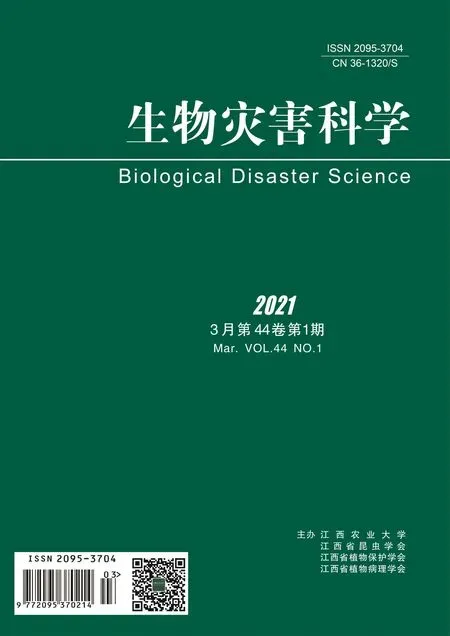Knowledge Map and Topics Analysis on the Research of Lycoris Research based on the Perspective of Literature Metrology
MA Meixia, WEI Xuying, ZHANG Lvshui, XU Lina, ZHANG Yao, CAI Junhuo
Knowledge Map and Topics Analysis on the Research ofResearch based on the Perspective of Literature Metrology
MA Meixia1, WEI Xuying2, ZHANG Lvshui1, XU Lina1, ZHANG Yao1, CAI Junhuo1*
(1. College of Landscape Architecture, Jiangxi Agricultural University, Nanchang 330045, China; 2. College of Art, Jiangxi University of Finance and Economics, Nanchang 330032, China)
[]In order to reflect the relationship between literatures quickly and efficiently and reveal the evolutionary path and hotspot, and predict the future trend ofresearches. []In 1990-2019, CiteSpace software was used for visual graphic analysis authors, institutes and key words related toresearch based on data sources of WOS and CNKI.[](1) Domestic researchers have formed a core group of authors in East China, but the cooperation between the different teams is relatively dispersed. (2) From the perspective of international cooperation level, the co-contribution in China is the largest. Among them, the Chinese Academy of Sciences published has the largest number of papers, and higher research level. (3) The research onhas experienced three stages: slow accumulation period, rapid growth period and stable growth period. And its research direction develops along the route of “interspecific relationship within genus-propagation and cultivation- pharmacology and pharmacodynamics-cytology and molecular biology-cross breeding”.[]The research ofmainly distributed in Asian countries such as China and Japan .On the whole, its research direction is developing from macro to micro.
; CiteSpace; research progress; hotspot analysis
Introduction
【Research significance】is known as “dragon claw flower” in folk[1], which has a character of spontaneous summer dormancy[2]. Because its leaves and flowers do not appear at the same time, it is also named as magic flower. For the beautiful flower shape and gorgeous color, it is also called as Chinese tulip[3]. Therefore, It is ideal materials of garden ground cover plant, flower border,anthemia and cut flower[4], and a new favorite of bulb flowers newly developed in recent years[5]. Furthermore,bulbs also contains a variety of alkaloids[6],polysaccharide andlectin[7], which have analgesic, antihypertensive, anti-inflammatory and antiviral effects[8]. Especially, in the treatment of poliomyelitis, myasthenia gravis, intestinal paralysis and senile dementia, it has significant effects, so its development potential is huge[9-10]. In addition, the unique dormancy habit is not compatible with thesubtropical humid climate in summer[11], so its scientific research value is special.【Previous Research Progress】At present, Domestic and foreign scholars have done a lot of research on, The contents are involving breeding,systematic classification and evolution, growth and development, propagation and cultivation techniques and resource exploitation and other aspects[12]. In recent years, the number of published articles has been increasing year by year, but there is no relevant report on its metrology research.【Starting point of this study and the key problems to be solved】In order to reflect the relationship between literatures quickly and efficiently, meanwhile, to discover the path of discipline evolution and research hotspots[13-15]. The author uses CiteSpace software to analyze the author, publishing organization and keywords.This paper aims to preliminarily reveal the evolution process and internal rules ofrelated researches. In addition, its purpose is to predict the future related research trends.
1 Materials and methods
1.1 Data sources
In order to ensure the reliability and comprehensiveness of the research data, WOS and CNKI were selected as the data sources in this paper, and the retrieval annual span was 1990—2019. In the Web of Science database, “” or “” is used as the subject to search. Literature types are limited to Articles and Reviews. In addition, the language of literature is English. A total of 148 papers were retrieved, and repeated and non-research literatures were removed. Finally, 137 foreign literatures were obtained, and forming the foreign sample database of this paper. In the CNKI periodical database, the topics are ‘’, ‘’, ‘’, and the retrieval year span was 1990—2019. There are 1 615 Chinese literatures were retrieved. Among them, including 1 394, 181 and 40 relevant literatures with ‘’, ‘’, ‘’ as the main titles were searched, respectively. Finally, the literature with inadequate conditions (including conferences, news, essays by scholars) or incomplete information was eliminated manually. There are 686 Chinese literatures, which form the domestic sample database of this paper.
1.2 Data transformation
First of all, Chinese and foreign literature were chosen, including the author, dispatch agencies, title, journal, keywords, abstract and so on and export it in RefWorks format. Secondly, CiteSpace 5.6. R.4 software is used to convert the initial data format. Finally, in parameter setting, node types are author, institution, country, and keywords, and the maximum threshold of annual citation frequency is 50. In addition, the method of cutting is pathfinder to obtain the knowledge atlas of authors, research institutions, keywords and other relevant knowledge.
2 Time and spatial distribution characteristics of Lycoris radiata research at domestic and abroad
2.1 Analysis of the time distribution of literatures
According to the number of literatures and the annual distribution trend, it can reflect the development level, degree and trend of this research field[16-17]. From figure 1, in recent 30 years, the number of published papers on domestic and foreignplants showed an overall trend, which was related to the increase of the number of SCI journals[18]. At the same time, this trend was also in line with the general growth trend of the number of scientific papers at domestic and abroad[19]. But, the number of papers published in foreign languages is far less than that in Chinese, which may be related to the origin and distribution ofin China.
In terms of development stages, the related research process can be roughly divided into the following three stages: (1) Initial stage (1990—2002),the research content mainly involves “morphological and cytological classification, growth habits, breeding” and other aspects. And the public paid little attention to the research; (2) Rapid development (2003—2012), people are very concerned about the research, and the research contents mainly focused on “cultivation management, bulb propagation technology, flowering regulation, growth and development mechanism, development and utilization”, etc. In this period, the number of published Chinese articles increased rapidly (by 10 articles annually to 59 by the end of 2012); (3) Transition stage (from 2013 to now), the research content gradually focused on “development mechanism and breeding of new varieties”. The amount of literature published showed a fluctuating rising trend, indicating that the researches focus ofwas constantly changing, and the content was also advancing from shallow to deep. Of course, research methods were increasingly advanced.

Fig.1 Time distribution of the publication amount of domestic and foreign Lycoris research
2.2 Spatial distribution characteristics
2.2.1 Analysis of literature authors Through theresearch literature of the author’s knowledge mapping, key researchers and their distribution in this field could be quantitatively identified.To some large extent, the research direction of core authors not only represents the focus and future trend of this field, but also represented the focus and future trend of this field[22]. At the same time,the degree of cooperation among different authors also reflects the research level and development stage of this field to some certain extent.

Table 1 Authors who published more than 3 papers on Lycoris

plant number in more than 10 papers in Chinese literature, author of a total of 20.6% of the total number (Table 2). Among them, Zhou Jian was the most influential and published 37 articles. His team mainly used RAPD and ISSR molecular markers to study the distribution of germplasm resources, genetic diversity and variation types, growth and development, cultivation, breeding and other aspects of. His team mainly used RAPD and ISSR molecular markers to study the distribution ofgermplasm resources, genetic diversity, variation types, growth and development, cultivation, breeding and other aspects of. Secondly, Xia Bing, Peng Feng, Zheng Yuhong, Zhou Shoubiao and other influential researchers carried out systematic studies on the physiological and ecological habits, cultivation, breeding, molecular genetics, identification of medicinal components and pharmacological effects of.

Table 2 Authors of more than 10 Chinese literatures on Lycoris
2.2.2 Analysis of literature authors’ cooperative network knowledge map In this paper, a knowledge map of cooperation among foreign authors who studiedwas drawn so as to clearly reflect the cooperation among authors. The connection between authors of literature in foreign languages is relatively close, and there is a strong cooperative research relationship between those authors (Fig.2). Especially, a stable research group has been formed among the top 10 core authors (such as Wang Ren, Xia Bing, Li Xiaodan, Kurita S, etc.).
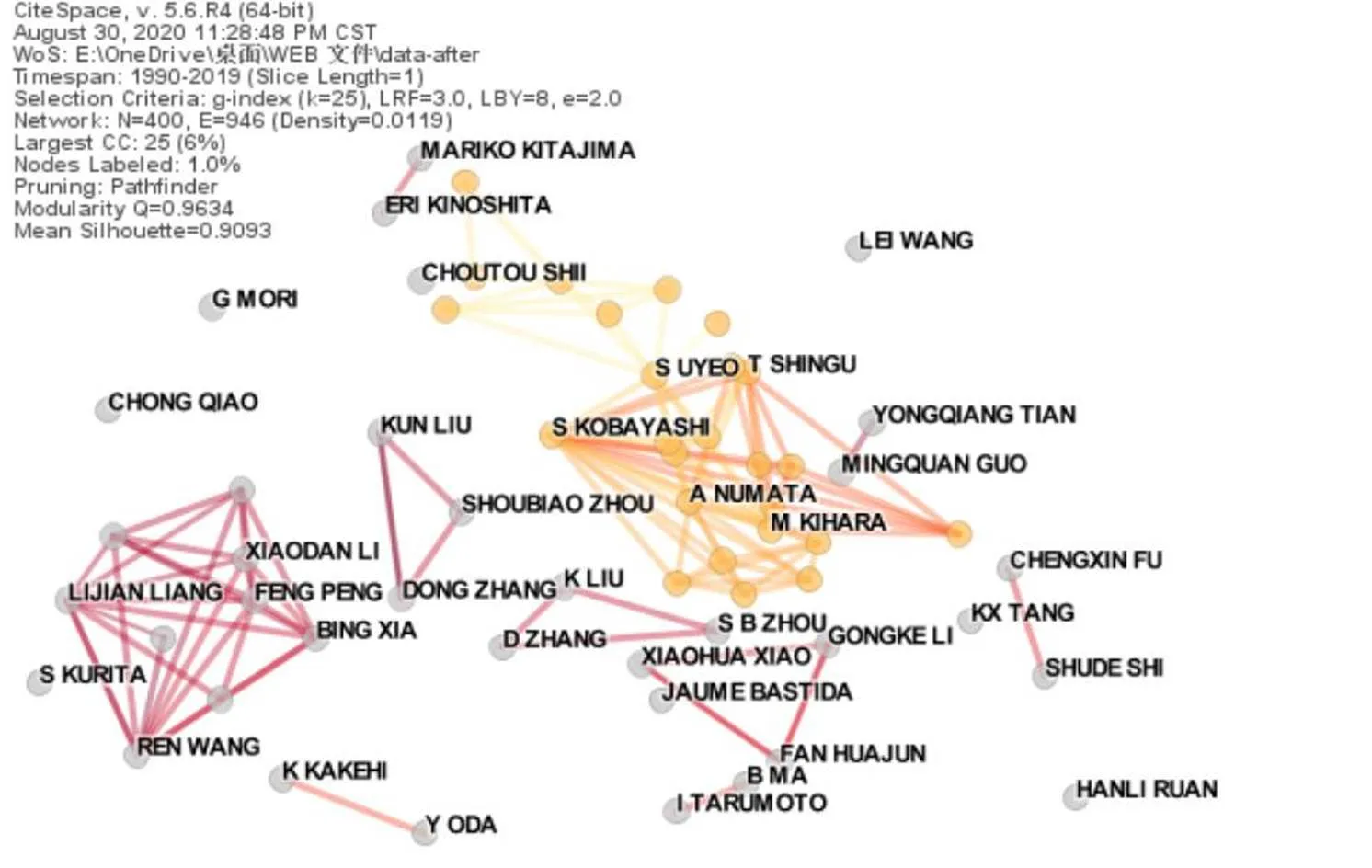
Fig.2 The author cooperation network exhibition of Chinese literature on Lycoris
The visual analysis of collaborative network of Chinese authors onresearch shows that there were core persons such as Zhou Jian and his teams in this field, and there were frequently academic communication and close cooperation between the research teams (Fig.3). In addition, it could be seen from the high frequency of mutual references that there were high academic resonance between domestic researchers. Those research teams were characterized by regional cooperation, especially in East and Central China (Jiangsu, Zhejiang, Jiangxi, Anhui). However, there was less cooperation between some research teams outside the core area.
Fig.3 Cooperation network of Chinese literature authors inresearch
2.3 Institutional analysis
The co-occurrence knowledge map ofresearch institutions (Fig.4, Table 3, and Table 4) shows that the research onat domestic and abroad are mainly concentrated in scientific research institutions and universities. And it was mainly distributed in Nanjing, Hangzhou, Wuhu, Nanchang and other places in East China. In addition, 222 articles were published, accounting for 18.41% of the total, which fully reflected the leading position of the regional institution in the research field of. The distribution of research institutions ofat domestic and abroad presents the phenomenon of “local concentration and overall dispersion”. At present, although a number of core teams and their institutions have been formed, there were relatively few cooperative relationships between those teams (Fig.4, Fig.5).

Table 3 Institutions that published more than 5 articles on Lycoris research
In terms of half-life, the most influential research institution foris the Chinese Academy of Sciences (Fig.4 and Table 3). The scientific research institution has the most connections with other institutions, its cooperation relationship in China is very obvious and concentrated, and its cooperation with foreign countries cooperation is also relatively close.
In terms of foreign language publications, the top three institutions are mainly concentrated in China and Japan, followed by Chinese Acad SCI, Anhui Normal Univ and Chiba Univ.
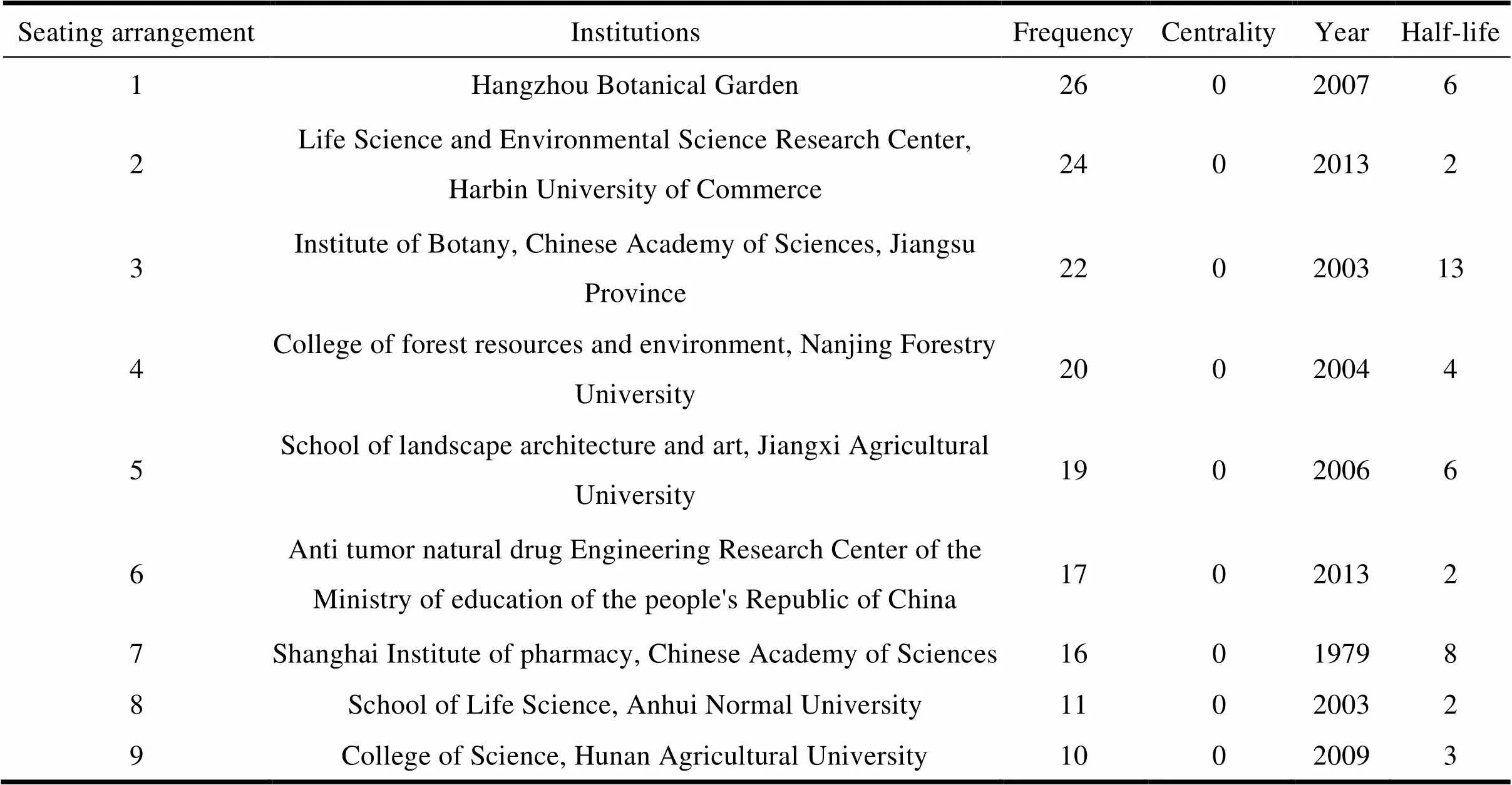
Table 4 Institutions with more than 10 papers published in Chinese literature of Lycoris research
As for Chinese literatures, Hangzhou Botanical Garden published the most frequently in China (Fig.5, Table 4), with 26 articles. Chinese literature, Hangzhou Botanical Garden (Fig.5 and Table 4), which published 26 papers with the highest frequency. followed by Harbin Commercial University (24 papers) and Institute of Botany of Chinese Academy of Sciences of Jiangsu Province (22 papers), then the Nanjing Forestry University and Jiangxi Agricultural University, with more than 10 papers published. Thus it can be seen that the domestic research onis mainly concentrated in Colleges and universities, followed by research institutes and relatively few enterprises.
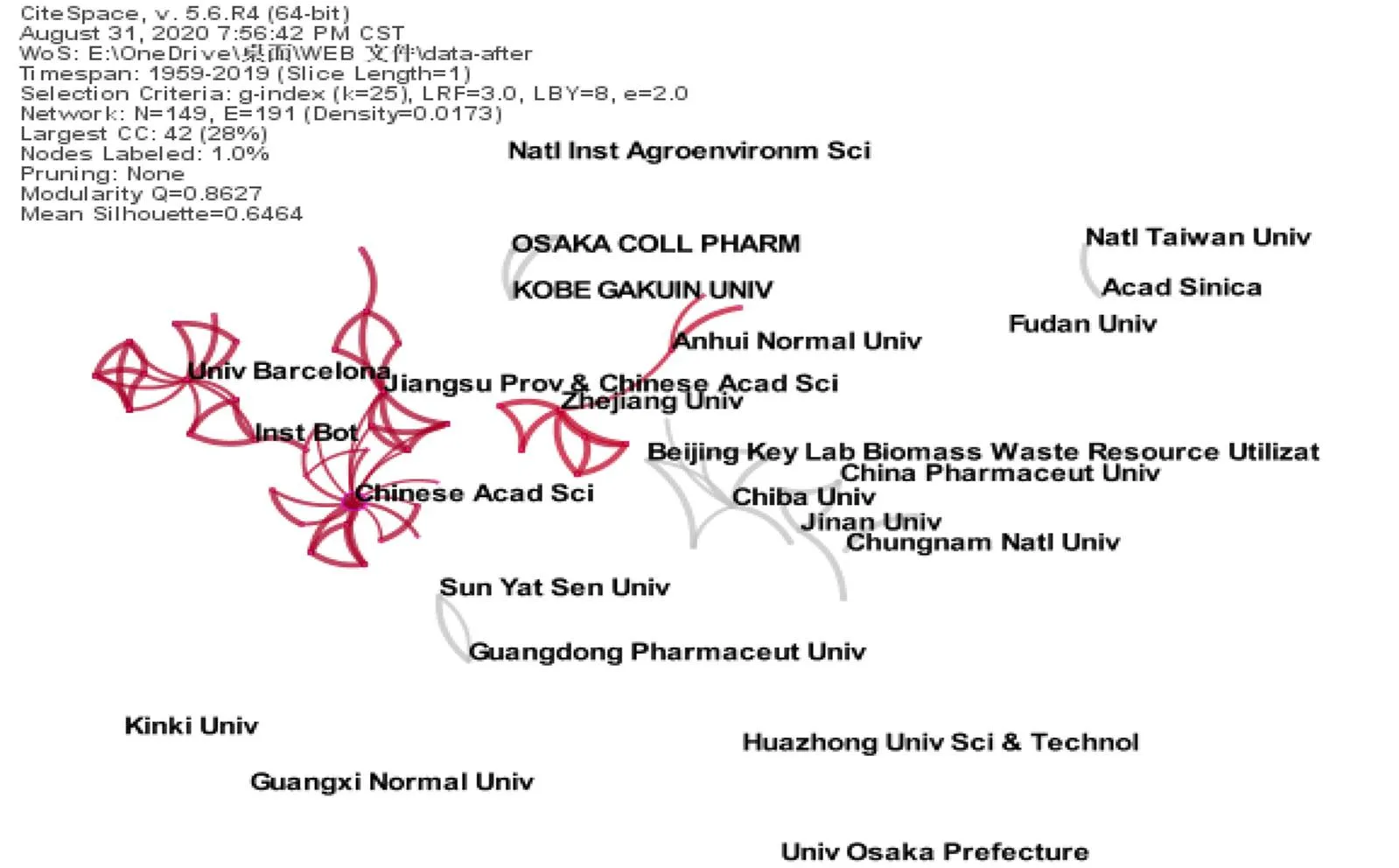
Fig.4 Cooperation network exhibition of foreign literature publishing institutions on Lycoris research

Fig.5 Cooperation network display of Chinese literature publishing institutions of Lycoris research
2.4 Keyword analysis
High frequency keywords represent the research hotspots in this field[20-21], which is an important way to reveal the main content of the paper[23-24]. The knowledge analysis map was generated by keyword co-occurrence analysis and cluster analysis of domestic literatures on. It can clearly reveal the overall development ofresearch and its hot spots in each stage.
2.4.1 Keyword co-occurrence analysis The key words “” or “” were used for retrieval, and 137 literatures were obtained after the removal of duplications and non-research literatures.The visualization and quantitative analysis ofby CiteSpace showed that the research hotspots ofin the world changed with time. Earlier researches mainly focused on the basic biological and ecological characteristics of Amaryllidaceae and, and then gradually paying close attention to its development and utilization (such as the efficacy of alkaloids and pharmacology, starch). and then the transition to these directions of cytology (such as karyotype analysis), closebreeding (hybrid generating), molecular biology(such as transcription omics, functional gene cloning and location), and other fields. The same method was used to import Chinese literature (686 pieces after redoing) into CiteSpace software to generate Table 5 and Figure 6. The result showed that the medicinal ingredients and pharmacological effects ofhave been widely concerned.

Table 5 High frequency keyword table of domestic and foreign Lycoris research (Top10)
From the frequency analysis of keyword occurrence, 11 keywords reached up to 20. Among them, “” appeared for a maximum of 217 times. In addition, the frequency of relevant keywords “, specific species or hybrid varieties within the genus” was 205 times in total. This further indicates that the related research mainly focused on the relationship betweengenera and its species characteristics. In addition, the occurrence of “Lycoridaceae alkaloids, alkaloids, galantamine or other alkaloids” was up to 201 times.These results indicate that in recent 30 years, the focus of domestic research onwas mainly on the chemical constituents, pharmacology, extraction technology and other aspects ofalkaloids.[25-31]
Fig.6 Knowledge map of keyword co-occurrence in foreign literature of
The knowledge map (from 1990 to 2020) showed that during the earlier stage of this study, we focused on the classification, development and utilization ofand its medicinal value. Therefore, its keywords appeared very frequently. Secondly, the growth and development of, propagation and cultivation, physiological and ecological research were paid attention to. Thirdly, in recent years, the research direction had gradually shifted to the cytology and molecular biology of.
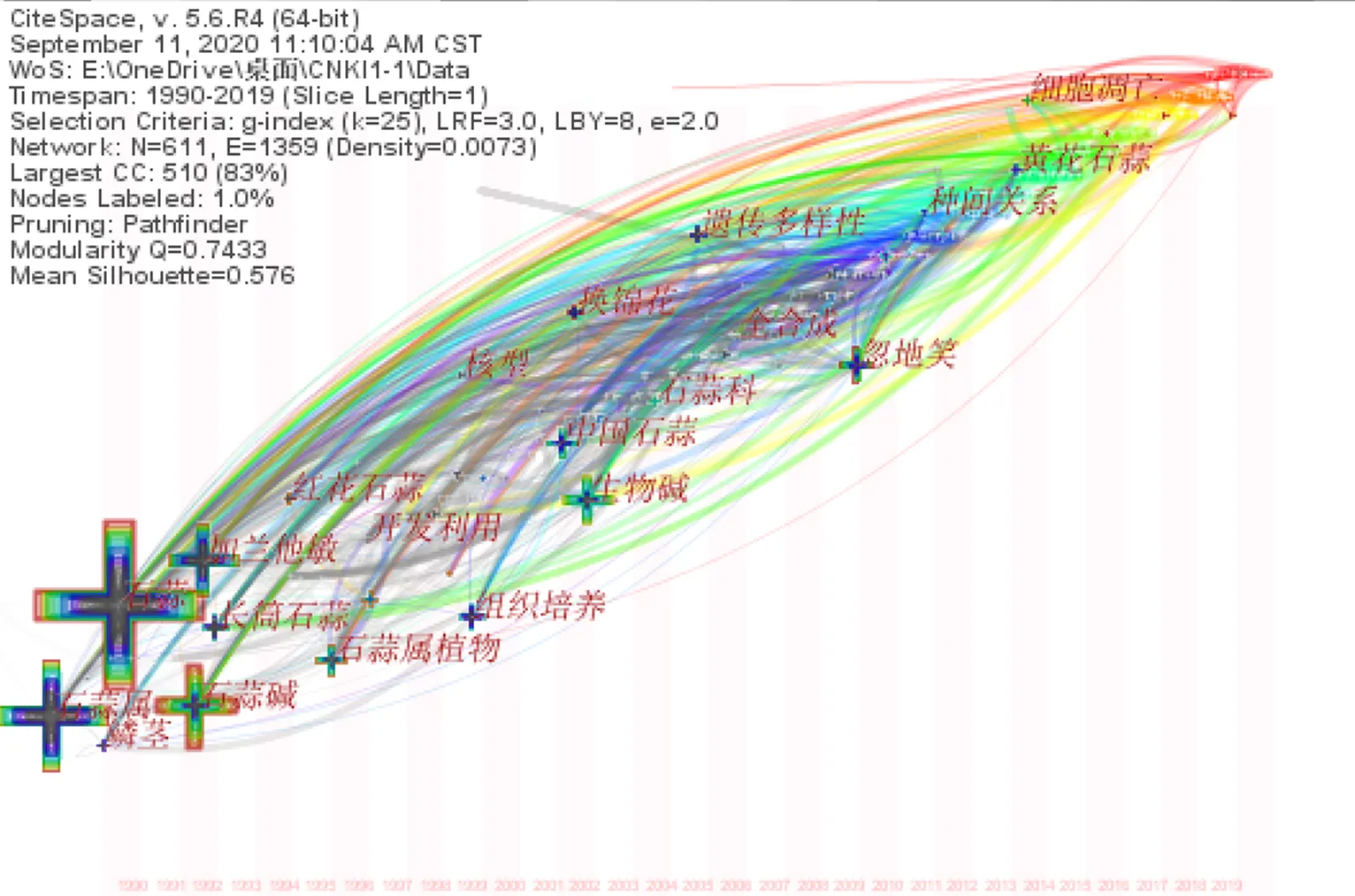
Fig.7 Knowledge map of keywords co-occurrence analysis of Lycoris in China
2.4.2 Cluster analysis By comparing the hot spot clustering ofresearch in Chinese and foreign literature, the main keywords are automatically clustered. Thus, the clustering network of Chinese keywords inrelated research literatures could be displayed, and we can found the similarities in hot areas. It could be found from the keyword clustering network shown in the following figure (Fig.8 and Fig.9), It was found that there were overlapping clusters in the two figures, indicating that these clusters were closely related. Although there were some differences in the research, the topic was concentrated.

Fig.8 Knowledge map of key words cluster analysis of Lycoris in China

Fig.9 Knowledge map of keywords cluster analysis of Lycoris in foreign countries
For example, in the cluster analysis atlas of key words ofin China (Fig.8), #2 and #4 are the research of; #0 and #5 are the research of medicinal value of. In the cluster analysis atlas of keywords studied byabroad, #3, #1 South Korea, molecular simulation are both studies on the molecular aspects of. #5 Effective Alkaloid Enrichment was a study onalkaloids. By summarizing the cluster analysis diagram.In recent years, it could be found that the research onat domestic and abroad mainly focused on the development and utilization value of alkaloids in, propagation and cultivation, and molecular research. For example, Qin Weihua et al. analyzed the karyotype of wild[32]. The results showed that the chromosome number of wildin Jiuhua Mountain was 2n = 22, 3 pairs of subtermocentric chromosomes and 8 pairs of telocentric chromosomes, Up to now, had not been reported in, which provided important basic information for the karyotype evolution and evolution mechanism of. Yao Jianhong et al. used modern molecular technology to clonelectin gene and study the insect resistance of transgenic plants.
2.4.3 Analysis of emergent words Emergence words and emergence rate could reflect the development trend of the research frontier of a discipline or a certain field. CiteSpace software was helpful to detect the emergence words, and could intuitively display the evolution path and interaction relationship between research frontiers[33-34]. Therefore, this paper was based on the analysis of data in the WOS database from 1990 to 2019, dividing the research and development ofinto the following two stages according to the emergence words and their time distribution characteristics (Fig.10).

Fig.10 Cluster analysis knowledge map of Lycoris in foreign countries
This paper was finished based on the analysis of data in the CNKI database from 1990 to 2019, dividing the researches and development ofinto the following three stages according to the emergence words and their time distribution characteristics (Fig.11).
The first stage: from 1990 to 2002, the key words of “”, or “” emergence words and their emergence rate were high, which showed that the study ofhad begun in China at this stage. At the same time,the research object was the interspecific relationship ofand the species within the genus.The research on other species ofalso appeared, which indicated that at this stage, people began to pay attention toplants, and its related research is still in its infancy.
The second stage: from 2003 to 2012, the words appeared in turn are “”, “genetic diversity”, “karyotype”, “fertilization” and so on. During this period, studies on asexual reproduction, intra hybridization and karyotype, plant developmental biology and cultivation techniques ofhave been further developed. Its research contents are diversified and level has been effectively improved[36-39].
The third stage: from 2013 to 2020, the key words are “alkaloids”, “apoptosis”, “lycorine”, and it lasts a long time.This shows that in recent years, scholars began to pay attention to the development and utilization of various alkaloids in the bulb ofAmaryllidaceae, and the research frontier showed a trend from macro to micro.This is consistent with the results of co-occurrence analysis, which shows that the research focus and frontier ofare changing in the development. From the emergent rate and the emergent time node of these keywords, the research ofis closely related to the national policy and scientific and technological progress.In terms of the period of influence of emergent words,had the longest period of development and utilization research (1990—2019), especially as for its pharmacological effects (such as antibacterial[40], antiviral[41], anti-tumor[42-43], etc.). According to relevant policy guidance, the development and utilization, propagation and cultivation, cytology and molecular biology ofwill still be the research focus of scholars.

Fig.11 Knowledge map of key words emergence analysis of Lycoris in China
3 Conclusion
In this paper, the CiteSpace software was used to make a visual analysis of knowledge map ofliterature data ofin WOS and CNKI databases from 1990 to 2019, and the following conclusions were drawn:
(1) As a whole, the publication amount of the research onat home and abroad shows an increasing trend of “slow-fast-slow”. Among them, from 2013 to now, there has been a leap up stage, which is consistent with the growth law of papers in other fields, but the number of published papers is far lower than that of other disciplines. This may be related to the hot spot transfer of this discipline, the rarity degree of existing species and the limitation of geographical distribution.
(2) The research strength ofmainly distributed in Asian countries such as China and Japan. In terms of the volume of publications and the influence of research institutions, China (especially universities and scientific research institutes in East China) has a leading position, but it needs to be further improved in terms of top journals, high-quality literature publication and international cooperation.
(3) Although there are abundant resources ofin China and a large number of relevant research papers have been published, and most of the research contents and frontiers are focused on the chemical composition analysis of alkaloids and their pharmacological effects. However, the research on its mechanism of action is not yet in-depth.
(4) From the perspective of the influence period of the word of emergence word, the development and utilization research ofhas the longest duration (30 years) and the widespread academic influence.In the early stage, the development and utilization, classification and karyotype evolution mechanism of the genus were mainly concerned, while in the middle stage, the breeding, growth and development of the species and its development and application were mainly concerned. Recently, people paid more attention to basic biology, flowering regulation and breeding. On the whole, it presents the development trend from macro to micro.
[1] Linghu Y W, Li D W. Advances in the research of[J]. Subtropical plant science, 2007, 36(2): 73.
[2] Liu K,Tang C F, Zhou S B, et al. Comparison of the photosynthetic characteristics of fourspecies with leaf appearing in autumn under field conditions[J]. Photosynthetica, 2012, 50(4): 570-576.
[3] Qin H. Colorful[J]. Popular flowers, 1986(3): 10-11.
[4] Dong G L. External treatment of[J]. Journal of external therapy of traditional Chinese medicine,1995(6): 31-32.
[5] Jin Y Q, Huang X F, Li D L.Resource ofin Jiangsu Province and its garden use[J]. Journal of Jinling institute of technology, 2003, 19(3): 17-21.
[6] Deng C L, Zhou J. Primary study on C-band ofsprengeri[J]. Journal of biology, 2004, 21(2): 18-19.
[7] Chang L Q, Wu C F, Lv H Z, et al.Purification and charaterization of agglutinin from bulbs of(Amaryllidaceae)[J]. Chinese journal of applied and environmental biology, 2005, 11 (2): 164-167.
[8] Jia X H, Zhou T S, Zheng Y, et al. Pharmacological study on Alkaloids from[J]. Chinese archives of traditional Chinese medicine, 2001(6): 573-574.
[9] Xu Z Y, Huang S J, Ruan L J. Transdermal absorption of galanthamine hydrobromide through mice skin[J]. Pharmaceutical care and research, 2002, 2(2): 88-91.
[10] Coyle J, Kershaw P, et al. Galanthamine, a cholinesterase inhibitor that allosterically modulates nicotinic receptors: effects on the course of Alzheimer’s disease[J]. Society of biological psychiatry, 2001, 49(3): 289-299.
[11] Wang R S.Ecogeography of[J].Journal of southwest forestry university,1990,10 (1):41-48.
[12] Cai J H ,Fan J J ,Wei X Y, et al.A three-dimensional analysis of summer dormancy in the red spider Lily ()[J]. Hortscience,2016,54(9):1459-1464.
[13] Cai J H, Wei X Y, Zhang L. Effects of different shading on leaf growth and flowering characters of[J]. Pratacultural science, 2011, 28(12): 2092-2095.
[14] Hu L, Xiao H. Development and research advance of pharmacognosy field based on CNKI[J]. China journal of Chinese materia medica, 2018, 43 (4): 689.
[15] Chen Y, Chen C M, Liu Z Y, et al.The methodology function of CiteSpace mapping knowledge domains[J].Studies in science of science,2015,33 (2): 242.
[16] Pan X L, Yan E J, Cui M, et al. Examining the usage, citation, and diffusion patt erns of bibliometric mapping software: a comparative study of three tools[J]. J Informetr, 2018, 12(2):481.
[17] Gao Y F, Xu Y N, Zhu Y X, et al.An analysis of the hotspot and frontier of mine eco-environment restoration based on big data visualization of VOS viewer and CiteSpace[J].Geological bulletin of China, 2018,37(12): 2144-2153.
[18] Larsen P O, Ins M V.The rate of growth in scientific publication and the decline in coverage provided by science citation Index[J]. Scientometrics, 2010, 84(3): 575-603.
[19] Wang C, Liu Y, Li X H, et al. Advances in the study of the genera of the genera of amylose based on bibliometrics[J]. Acta ecologica Sinica, 2016, 36(16): 5276-5283.
[20] Xiao L M, Xiao Q L. Study on progress and hot issues of green innovation at home and abroad visual analysis based on CiteSpace [J]. Resource development & market, 2018, 34(9): 1212-1220.
[21] Cao Y Q, Zhu M M.Bibliometric analysis on research hotspots and trends of air pollution in China in recent 20 years [J].Journal of North China university of water resources and electric power, 2016, 37(3): 76-81.
[22] Liu L, Bai X G, Jiang Z D.Knowledge map of domestic research on conservation tillage[J]. Journal of arid land resources and environment, 2019, 33(4): 76-81.
[23] Tian T, Zhang Y, Wang C H. Research hotspots and development direction of comprehensive journals of internal medicine from 2009 to 2013 through keyword frequency analysis[J]. Chinese journal of medical research management, 2016, 29(1): 32-37.
[24] Li S S, Zhang W Y, Sun C H, et al. Status and trends analysis on remediation of polluteo soil in china based on literature motrology[J].Environmental engineering,2015,33(5):160-165.
[25] Zhao R Y, Xu L M. The knowledge map of the evolution and research frontiers of the Bibliometrics[J]. Journal of library science of China, 2010 (5): 60-68.
[26] Wang X Y, Huang M R, Han Z M. Separation of galanthamine from Amaryllidaceae family and the application in medicine[J]. Journal of Nanjing forestry university (Natural science edition), 2004, 28(4): 79-83.
[27] Wang X Y, Huang M R, Han Z M. Microwave assisted extraction of galanthamine in[J]. Journal of Nanjing university of traditional Chinese medicine, 2005, 21 (6): 374-375.
[28] Xiao G X. Study on extraction of galanthaminefromby supercritical extraction technology[D]. Tianjin: of Tianjin university, 2005.
[29] Wang X Y, Huang M R, Han Z G, et al. GC-MS analysis of the chemical constituents in[J]Chinese Herbal medicine, 2007, 38 (12): 188-188.
[30] Li Y Z, Shan Y, Wu Z P, et al.Determination of total alkaloids in bulb ofby UV-spectrophotography[J]. Lishizhen medicine and materia medica research, 2007, 18(7): 1695-1696.
[31] Xie J, Tan F, Feng W , et al. Advances in studies on classification, identification, medicinal ingradients, and biotechnological application of plants inHerb.[J]. Chinese Traditional and Herbal Drugs, 2007, 38(12): 902-1902.
[32] Qin W H, Yu B Q, Zhou S B, et al. Karyotype studies onform Jiuhuashan population in Anhui Province[J]. Journal of Anhui normal university, 2004, 27(4): 440-442.
[33] Li X, Xiong Y F, Jiang L H, et al.Research on the evolution and development of land resource management in China based on the discipline knowledge map[J]. Henan chemical industry, 2008, 27(6): 904-912.
[34] Liu L Z, Zhou W J, Zheng R B, et al. Research on the evolution and development of land resource management in China based on the discipline knowledge map[J]. Journal of China agricultural university, 2017, 22(1): 189-202.
[35] Zhou S B, Qin W H, Yu B Q, et al. Karyotype studies onfrom two populations in Anhui Province[J]. Acta Botanica Yunnanica, 2004, 26(4): 421-426.
[36] Liu Y, Hsu B S. Mechanism of sterility of diploid hybridin genus[J].Acta agr Shanghai, 1990, 6(2): 27-30.
[37] Traub H P.,.and.[J]. Plant life, 1957, 13: 42-48.
[38] Xie J Y, Zhang Lu, Lian F Q, et al. Effects of growth regulator on the bulb propagation ofHerb[J]. Journal of Nanjing forestry university (Natural science edition), 2006, 30(3): 125-127.
[39] Cai J H, Wei X Y, Fu Z Y, et al. Advance in developmental biology and cultivation techniques ofHerbs[J]. Jiangxi forestry science and technology, 2009(5): 21-24.
[40] Chen C, Morris S. Visualizing evolving networks: minimum spanning trees versus pathfinder networks[C]//IEEE Symposium on Information Visualization, 2003(9): 19-21.
[41]Chengsman L, Nair J J, Staden J V, et al. Antibacterial activity of crinane alkaloids from(Amaryllidaceae) [J]. Journal of ethnopharmacology, 2012, 140(2): 405-408.
[42] Liu J, Yang Y, Xu Y, et al. Lycorine reduces mortality of human enterovirus 71-infected mice by inhibiting vi-rus replication[J]. Virology journal, 2011, 8(1): 483-483.
[43] Kornienk A E A. Anticancer evaluation of structur-ally diverse Amaryllidaceae alkaloids and their synthetic derivatives[J]. Phytochemistry reviews, 2009, 8(2): 449-459.
Date of receipt: 2021-02-03
Date of modify: 2021-03-10
Fund project: Project supported by the National Natural Science Foundation of China (31960327, 31560226) and Natural Science Foundation of Jiangxi Province (20202BABL205004)
Author introduction: MA Meixia (1994—), graduate, mainly engaged in garden plant cultivation and application research, 2462317517@qq.com; *Corresponding author: CAI Junhuo, professor, master supervisor, Doctoral candidate, Cjhuo7692@163.com.
Code of Chinese Library Classification Number: S682.29
Document Identification: A
Article Number:2095-3704(2021)01-064-13
MA M X, WEI X Y, ZHANG L S, et al. Knowledge map and topics analysis on the research ofresearch based on the perspective of literature metrology[J]. Biological disaster science, 2021, 44(1):64-76.

